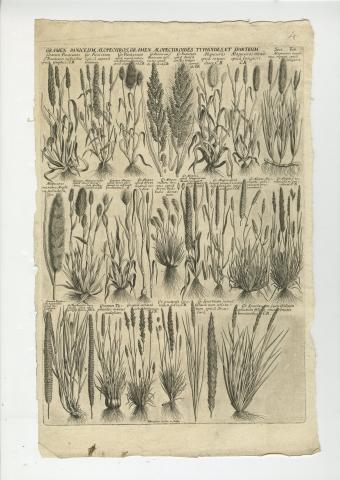Proofs of Morison's prints
Scientific publishing is a complex process, where attention to detail is essential if a work is to do justice to its author’s efforts, and be a source of reliable information. Investigation of proofs, especially for grand, long-term projects such as Morison’s Historia, is a means of gaining insight into the practicalities of scientific editing in the late seventeenth century. Moreover, it reveals how constantly, and rapidly, emerging new knowledge was incorporated into the slow process of copper plate engraving. Information relevant to some of thee issues is revealed by the examination of proofs associate with the grasses in the Historia.
Joseph Strutt (1786: 161) summed up Michael Burghers’ (c.1647-1727) work as an engraver thus: ‘he worked almost wholly with the graver, in a stiff, tasteless style, without genius, or knowledge of the art of design’. Strutt evidently had not seen, or appreciated, Burghers’ work on the grasses, rushes and sedges for Part 3 of Morison’s Historia. Grasses tend to be overlooked, despite them being the primary food stuff of humans. When depicted, they are frequently highly stylised, meaning it can be difficult to make confident identifications based solely on images. Many of Burghers’ images of grasses are remarkable for the late seventeenth century; few better images were published until the mid-eighteenth century. They are clearly drawn from life, although the models do not appear to have survived to the present day – if specimens were ever made. Burghers focused on key features of the plant’s habit and seed heads, and was presumably working closely with Morison and/ or Bobart the Younger to achieve these results.
The quality of Burghers’ work becomes immediately apparent when it is compared with a plate of grasses from the Historia, where he largely copied images from published sources.
Reference
Strutt, J (1785) A biographical dictionary; containing an historical account of all the engravers, from the earliest period of the art of engraving to the present time. Vol. 1. London, printed by J. Davis, for Robert Faulder, New Bond Street.

![Image for Proof, published plate and reverse of the copper printing plate of ‘GRAMINA LOLIACEA, DACTYLA, PHALARIS, PANICUM, ijsq[ue] congenera’ from Morison’s Historia Plantarum Universalis Oxoniensis (1699: Sect. 8, Tab. 3). Plants drawn and copper plate engraved](https://www.cabinet.ox.ac.uk/sites/default/files/styles/large/public/images/sources/08-01a.jpg?itok=vu9sdmtr)
